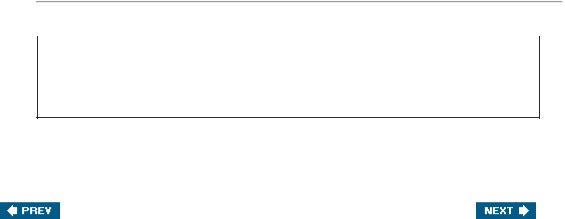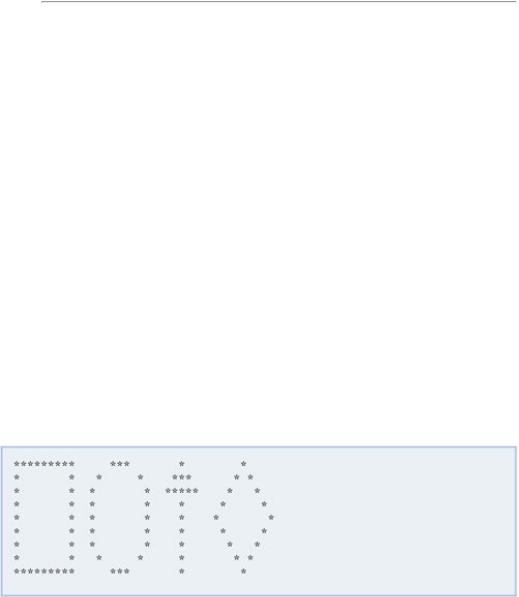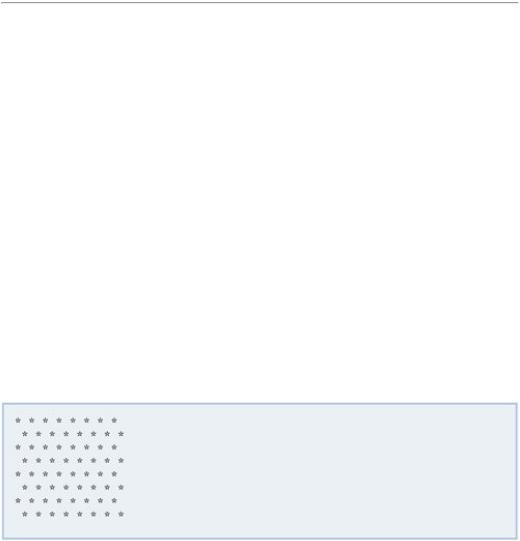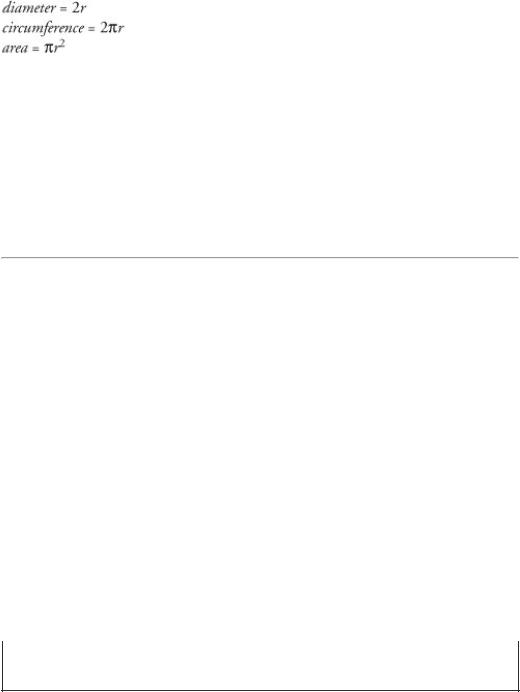
AhmadLang / Java, How To Program, 2004
.pdf
precedence primitive type
programmer-defined class prompt
public keyword redundant parentheses relational operators
< "is less than"
<= "is less than or equal to" > "is greater than"
>= "is greater than or equal to" remainder operator (%)
reserved words
[Page 74]
right brace (})
rules of operator precedence
%s format specifier
Scanner class self-documenting semicolon (;) shell
single-line comment (//) size of a variable
standard input object (System.in) standard output object (System.out) statement
straight-line form string
string literal

subtraction operator (-) syntax error
System class
System.in (standard input) object
System.out (standard output) object
System.out.print method
System.out.printf method
System.out.println method
terminal window
traditional comment (/* */)
true
type of a variable user-defined class variable
variable declaration
variable declaration statement variable name
variable value void keyword white space
white-space characters

[Page 74 (continued)]
Self-Review Exercises
2.1 Fill in the blanks in each of the following statements:
a.A(n) _____ begins the body of every method, and a(n) _____ ends the body of every method.
b.Every statement ends with a(n) _____.
c.The _____ statement is used to make decisions.
d._____ begins an end-of-line comment.
e._____, _____, _____ and _____ are called white space.
f._____ are reserved for use by Java.
g.Java applications begin execution at method _____.
h.Methods _____, _____ and _____ display information in the command window.
2.2 State whether each of the following is true or false. If false, explain why.
a.Comments cause the computer to print the text after the // on the screen when the program executes.
b.All variables must be given a type when they are declared.
c.Java considers the variables number and NuMbEr to be identical.
d.The remainder operator (%) can be used only with integer operands.
e.The arithmetic operators *, /, %, + and - all have the same level of precedence.
2.3 Write statements to accomplish each of the following tasks:
a.Declare variables c, thisIsAVariable, q76354 and number to be of type int.
b.Prompt the user to enter an integer.
c.Input an integer and assign the result to int variable value. Assume Scanner variable input can be used to read a value from the keyboard.
d.d) If the variable number is not equal to 7, display "The variable number is not equal to 7".
e. Print "This is a Java program" on one line in the command window.
f.Print "This is a Java program" on two lines in the command window. The first line should end with Java. Use method System.out.println.
g.Print "This is a Java program" on two lines in the command window. The first line should end with Java. Use method System.out.printf and two %s format specifiers.
[Page 75]

2.4 Identify and correct the errors in each of the following statements:
a. if |
(c |
< 7 |
); |
|
|
|
|
|
|
|
System |
.out.println( |
"c |
is |
less |
than |
7" |
); |
|
b. if |
(c |
=> |
7 ) |
|
|
|
|
|
|
|
System |
.out.println( |
"c |
is |
equal |
to |
or |
greater than 7" ); |
|
2.5 Write declarations, statements or comments that accomplish each of the following tasks:
a.State that a program will calculate the product of three integers.
b.Create a Scanner that reads values from the standard input.
c.Declare the variables x, y, z and result to be of type int.
d.Prompt the user to enter the first integer.
e.Read the first integer from the user and store it in the variable x.
f.Prompt the user to enter the second integer.
g.Read the second integer from the user and store it in the variable y.
h.Prompt the user to enter the third integer.
i.Read the third integer from the user and store it in the variable z.
j. Compute the product of the three integers contained in variables x, y and z, and assign the result to the variable result.
k.Display the message "Product is" followed by the value of the variable result.
2.6 Using the statements you wrote in Exercise 2.5, write a complete program that calculates and prints the product of three integers.

[Page 75 (continued)]
Answers to Self-Review Exercises
2.1 a) left brace ({), right brace (}). b) semicolon (;). c) if. d) //. e) Blank lines, space characters, newline characters and tab characters. f) Keywords. g) main. h) System.out.print,
System.out.println and System.out.printf.
2.2 a. False. Comments do not cause any action to be performed when the program executes. They are used to document programs and improve their readability.
b.True.
c.False. Java is case sensitive, so these variables are distinct.
d.False. The remainder operator can also be used with noninteger operands in Java.
e.False. The operators *, / and % are on the same level of precedence, and the operators + and - are on a lower level of precedence.
2.3 |
a. int |
c, thisIsAVariable, q76354, number; |
|
or |
|
|
int |
c; |
|
int |
thisIsAVariable; |
|
int |
q76354; |
|
int |
number; |
b.System.out.print( "Enter an integer: " );
c.value = input.nextInt();
d.if ( number != 7 )
System.out.println( "The variable number is not equal to 7" );
e.System.out.println("This is a Java program");
f.System.out.println("This is a Java\nprogram");
g.System.out.printf("%s\n%s\n", "This is a Java", "program");
2.4 The solutions to Self-Review Exercise 2.4 are as follows:
a.Error: Semicolon after the right parenthesis of the condition (c < 7) in the if. Correction: Remove the semicolon after the right parenthesis. [ Note : As a result, the output statement will execute regardless of whether the condition in the if is true.]
b.Error: The relational operator => is incorrect. Correction: Change => to >=.
[Page 76]
2.5 a. // Calculate the product of three integers
b.Scanner input = new Scanner( System.in );
c.int x, y, z, result; or
int x; int y; int z;
int result;

d.System.out.print( "Enter first integer: " );
e.x = input.nextInt();
f.System.out.print( "Enter second integer: " );
g.y = input.nextInt();
h.System.out.print( "Enter third integer: " );
i.z = input.nextInt();
|
j. result = x * y * z; |
|
|
|
|
|
k. System.out.printf( "Product |
is |
%d\n", |
result |
); |
2.6 The solution to Exercise 2.6 is as follows: |
|
|
|
||
1 |
// Ex. 2.6: Product.java |
|
|
|
|
2 |
// Calculate the product of three integers. |
||||
3 |
import java.util.Scanner; |
// |
program |
uses |
Scanner |
4 |
|
|
|
|
|
5public class Product
6{
7public static void main( String args[] )
8{
9// create Scanner to obtain input from command window
10Scanner input = new Scanner( System.in );
11
12int x; // first number input by user
13int y; // second number input by user
14int z; // third number input by user
15int result; // product of numbers
16
17System.out.print( "Enter first integer: " ); // prompt for input
18x = input.nextInt(); // read first integer
19
20System.out.print( "Enter second integer: " ); // prompt for input
21y = input.nextInt(); // read second integer
22
23System.out.print( "Enter third integer: " ); // prompt for input
24z = input.nextInt(); // read third integer
25
26 result = x * y * z; // calculate product of numbers 27
28 System.out.printf( "Product is %d\n", result ); 29
30 } // end method main
31
32 } // end class Product
[Page 77]
Enter first integer: 10
Enter second integer: 20
Enter third integer: 30
Product is 6000

[Page 77 (continued)]
Exercises
2.7Fill in the blanks in each of the following statements:
a._____ are used to document a program and improve its readability.
b.A decision can be made in a Java program with a(n) _____.
c.Calculations are normally performed by _____ statements.
d.The arithmetic operators with the same precedence as multiplication are and _____.
e.When parentheses in an arithmetic expression are nested, the _____ set of parentheses is evaluated first.
f.A location in the computer's memory that may contain different values at various times throughout the execution of a program is called a(n) _____.
2.8Write Java statements that accomplish each of the following tasks:
a.Display the message "Enter an integer:", leaving the cursor on the same line.
b.Assign the product of variables b and c to variable a.
c.State that a program performs a sample payroll calculation (i.e., use text that helps to document a program).
2.9State whether each of the following is true or false. If false, explain why.
a.Java operators are evaluated from left to right.
b.The following are all valid variable names: _under_bar_, m928134, t5, j7, her_sales$, his_$account_total, a, b$, c, z and z2.
c.A valid Java arithmetic expression with no parentheses is evaluated from left to right.
d.The following are all invalid variable names: 3g, 87, 67H2, h22 and 2h.
2.10Assuming that x = 2 and y = 3, what does each of the following statements display?
a.System.out.printf( "x = %d\n", x );
b. System.out.printf( "Value of %d + %d is %d\n", x, x, ( x + x ) );
c.System.out.printf( "x =" );
d.System.out.printf( "%d = %d\n", ( x + y ), ( y + x ) );
2.11Which of the following Java statements contain variables whose values are modified?
a. p = i + j + k + 7 ;
b. System.out.println( "variables whose values are destroyed" );
c.System.out.println( "a = 5" );
d.value = input.nextInt();
2.12Given that y = ax3 + 7, which of the following are correct Java statements for this equation?

a. y = a * x * x * x + 7 ;
b. y = a * x * x * ( x + 7 );
c. y = ( a * x ) * x * ( x + 7 );
d. y = ( a * x ) * x * x + 7 ;
e. y = a * ( x * x * x ) + 7 ;
f.y = a * x * ( x * x + 7 );
2.13State the order of evaluation of the operators in each of the following Java statements, and show the value of x after each statement is performed:
[Page 78]
a.x = 7 + 3 * 6 / 2 - 1 ;
b.x = 2 % 2 + 2 * 2 - 2 / 2 ;
c.x = ( 3 * 9 * ( 3 + ( 9 * 3 / ( 3 ) ) ) );
2.14Write an application that displays the numbers 1 to 4 on the same line, with each pair of adjacent numbers separated by one space. Write the program using the following techniques:
a.Use one System.out.println statement.
b.Use four System.out.print statements.
c.Use one System.out.printf statement.
2.15Write an application that asks the user to enter two integers, obtains them from the user and prints their sum, product, difference and quotient (division). Use the techniques shown in Fig. 2.7.
2.16Write an application that asks the user to enter two integers, obtains them from the user and displays the larger number followed by the words "is larger". If the numbers are equal, print the message "These numbers are equal." Use the techniques shown in Fig. 2.15.
2.17Write an application that inputs three integers from the user and displays the sum, average, product, smallest and largest of the numbers. Use the techniques shown in Fig. 2.15. [Note: The calculation of the average in this exercise should result in an integer representation of the average. So if the sum of the values is 7, the average should be 2, not 2.3333....]
2.18Write an application that displays a box, an oval, an arrow and a diamond using asterisks (*), as follows:
2.19What does the following code print?
System.out.println( "*\n**\n***\n****\n*****" );

2.20What does the following code print?
System.out.println( "*" ); System.out.println( "***" ); System.out.println( "*****" ); System.out.println( "****" ); System.out.println( "**" );
2.21What does the following code print?
System.out.print( "*" ); System.out.print( "***" ); System.out.print( "*****" ); System.out.print( "****" ); System.out.println( "**" );
[Page 79]
2.22What does the following code print?
System.out.print( "*" ); System.out.println( "***" ); System.out.println( "*****" ); System.out.print( "****" ); System.out.println( "**" );
2.23What does the following code print?
System.out.printf( "%s\n%s\n%s\n", "*", "***", "*****" );
2.24Write an application that reads five integers, determines and prints the largest and smallest integers in the group. Use only the programming techniques you learned in this chapter.
2.25Write an application that reads an integer and determines and prints whether it is odd or even. [Hint: Use the remainder operator. An even number is amultiple of 2. Any multiple of 2 leaves a remainder of 0 when divided by 2.]
2.26Write an application that reads two integers, determines whether the first is a multiple of the second and prints the result. [Hint : Use the remainder operator.]
2.27Write an application that displays a checkerboard pattern, as follows:
2.28Here's a peek ahead. In this chapter, you have learned about integers and the type int. Java can also represent floating-point numbers that contain decimal points, such as 3.14159. Write an application that inputs from the user the radius of a circle as an integer and prints the circle's diameter, circumference and area using the floating-point value 3.14159 for p Use the techniques shown in Fig. 2.7. [Note: You may also use the predefined constant Math.PI for the

value of p. This constant is more precise than the value 3.14159. Class Math is defined in
package java.lang. Classes in that package are imported automatically, so you do not need to import class Math to use it.] Use the following formulas (r is the radius):
Do not store the results of each calculation in a variable. Rather, specify each calculation as the value that will be output in a System.out.printf statement. Note that the values produced by the circumference and area calculations are floating-point numbers. Such values can be output with the format specifier %f in a System.out.printf statement. You will learn more about floating-point numbers in Chapter 3.
2.29Here's another peek ahead. In this chapter, you have learned about integers and the type int. Java can also represent uppercase letters, lowercase letters and a considerable variety of special symbols. Every character has a corresponding integer representation. The set of characters a computer uses and the corresponding integer representations for those characters is called that computer's character set. You can indicate a character value in a program simply by enclosing that character in single quotes, as in 'A'.
[Page 80]
You can determine the integer equivalent of a character by preceding that character with (int), as in
(int) 'A'
This form is called a cast operator. (You will learn about cast operators in Chapter 4.) The following statement outputs a character and its integer equivalent:
System.out.printf(
"The character %c has the value %d\n" , 'A' , ((int ) 'A' ));
When the preceding statement executes, it displays the character A and the value 65 (from the
so-called Unicode® character set) as part of the string. Note that the format specifier %c is a placeholder for a character (in this case, the character 'A').
Using statements similar to the one shown earlier in this exercise, write an application that displays the integer equivalents of some uppercase letters, lowercase letters, digits and special symbols. Display the integer equivalents of the following: A B C a b c 0 1 2 $ * + / and the blank character.
2.30Write an application that inputs one number consisting of five digits from the user, separates the number into its individual digits and prints the digits separated from one another by three spaces each. For example, if the user types in the number 42339, the program should print
4 2 3 3 9
Assume that the user enters the correct number of digits. What happens when you execute the program and type a number with more than five digits? What happens when you execute the program and type a number with fewer than five digits? [Hint: It is possible to do this exercise with the techniques you learned in this chapter. You will need to use both division and remainder operations to "pick off" each digit.]
2.31 Using only the programming techniques you learned in this chapter, write an application that
